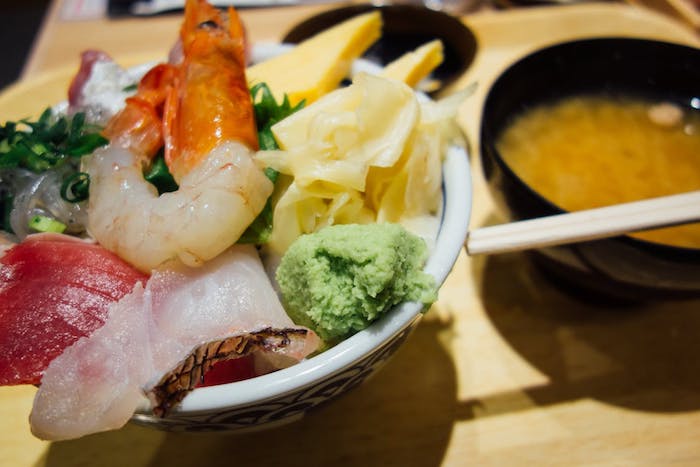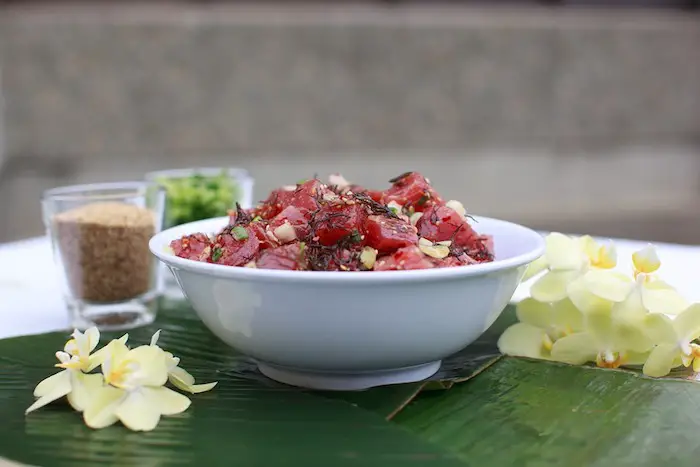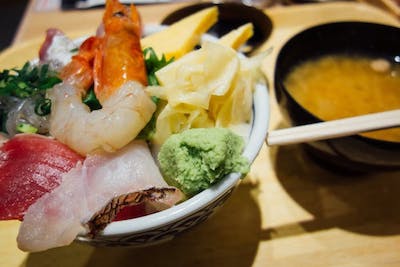We are reader supported. When you purchase through links on our site, we may earn an affiliate commission. Also, as an Amazon affiliate, we earn from qualifying purchases.

If you are a non-Japanese, it’s understandable if you don’t understand the meaning of Chirashi. Interestingly, there are many sushi fans I know who have no idea about this Japanese delicacy and they are often taken by surprise to see sushi in a bowl!
What is Chirashi sushi? This is a Japanese name for a type of sushi dish that is served in a shallow bowl, with sushi rice at the bottom and fish and veggies arranged beautifully on the top. As there’s no rolling or shaping involved, it is often called as the scattered sushi or sushi rice salad.
This is the no-fuss kind of sushi that Japanese families love to make at home. It takes less time to prepare and can be conveniently made from leftovers from a sushi dinner comprising of rolls and nigiri. If that makes you curious to find out how this dish is prepared or eaten, read on to find the juicy details.
What I like best about Chirashi is that it does not require a lot of sushi skills that are typically the domain of master chefs. If someone has just started taking an interest in this traditional delicacy and wishes to make sushi at home, Chirashizushi is the easiest way to start.
Contents
Chirashi (Sushi Rice And Fish Bowl) Recipe
A bowl of chirashi with seasoned sushi rice, 2-3 varieties of sushi-grade fish, veggies, seaweed, and ikura for garnishing is an artistic delight. It not only paints a colorful picture but also delivers an explosion of textures and flavors. Here is the recipe containing tuna and salmon. You may substitute them with yellowtail and ahi.
What you will need:
- Cooked and seasoned sushi rice
- 6 ounces of sushi-grade albacore tuna
- 6 ounces of sushi-grade salmon
- 3 ounces ikura (salmon roe)
- 5 tablespoons soy sauce
- 1 tablespoon wasabi
- Japanese cucumber
- Pickled ginger, finely chopped
- Nori sheets, cut into thin shreds
Instructions
The base for any good maki roll, nigiri sushi or chirashi is perfectly made sushi rice. However, given the fact that chirashi doesn’t involve any shaping or rolling with rice, mistakes may be ignored. I have created an article that contains step-by-step instructions on how to cook and season sushi rice.
The biggest part of making chirashizushi is preparing the toppings so let’s start with the raw fish. Take a medium bowl and mix wasabi and soy sauce evenly. Now, use a sharp sushi knife to cut salmon and tuna into half-inch cubes. Mix the fish cubes with the soy sauce and wasabi paste.
Shred the Nori seaweed into small pieces and chop the Japanese cucumbers into half-inch cubes with skin on. The crunchy cucumbers add freshness and green color to the dish.
Start arranging the chirashi sushi by spreading seasoned rice at the bottom of a large-sized shallow bowl and then top it with pickled ginger and Nori pieces.
Now, add the seasoned fish cubes and cucumber on the top of the rice. Garnish with fish eggs and serve immediately. You may substitute fish cubes with the fish cut in sashimi style.
Chirashi Vegan Recipe
Many people consider sushi as the domain of raw fish eater but this is not true. You will be surprised to know that most of the traditional chirashi sushi served in Japan actually contains no fish or meat. In this dish, you will find several unique ingredients such as lotus roots, fish cakes, and bamboo shoots, that are not used in other types of sushi. Here’s a purely vegan recipe for you.
What you will need:
- Cooked and seasoned sushi rice
- 3 shitake mushrooms
- 1 medium renkon
- 1 abura age
- 1 carrot
- 1 small gobo
- 1 cup bamboo shoots
- Kampyo (gourd strips)
- Lotus Roots
- Blanched Snow Peas for garnishing
For the veggie seasoning:
- 1.5 cups water
- 3 tablespoons soy sauce
- 2 tablespoons mirin
- 2 tablespoons sugar
Instructions
Prepare sushi rice at least 30 minutes in advance of your dinner time. Let it cool down to room temperature before seasoning it with vinegar, salt, and sugar. See the detailed instructions mentioned in this article.
While the rice cools, you can prepare the vegetable toppings. Take the rehydrated shitake mushrooms (soaked overnight in water) and cut into thin strips.
Soak the dried lotus roots to rehydrate them or if you bought them frozen then allow some time to thaw properly before you cut into thin slices.
Rinse the abura age in boiling water so that it turns soft and then cut into strips. You may semi-boil the carrot or use them fresh, diced into small pieces.
Rub kampyo with salt to break the fiber and then wash off the salt. Soak in water overnight with shitake mushrooms or minimum for 3 hours. Boil kampyo for 10 minutes or until they turn soft and then cut into small pieces.
Cut the bamboo shoots into small pieces. Soak gobo for 5 minutes, peel, and cut into thin strips. Peel the renkon and slice into small pieces.
To prepare vegetables, mix all veggie seasonings in a medium saucepan and heat until sugar is properly dissolved. Now add the veggies and simmer until all liquid evaporates.
Strain the seasoned veggies and add them to sushi rice in a bowl. If the sushi rice is still in the hangiri, you may mix rice and veggies there and then distribute portions in serving bowls.
Garnish with thinly sliced Nori strips (get the organic Kizami Nori from Amazon for best results) and blanched snow peas. To blanch snow peas, boil water with a pinch of salt and cook the snow peas for 2 mins. Strain and immediately transfer to cold water, strain again and use as garnish.
Types Of Chirashi Sushi And Their Origins
There are basically two types of Chirashi sushi. The first is the fancy version with beautifully arranged sashimi slices on the top. You will typically find this style of scattered sushi served at the restaurants where presentation is important.
According to the sushi traditionalists, the origins of chirashi came from chefs wanting to get rid of the unused, excess and unappealing pieces of fish after utilized the prized portions for sashimi and nigiri. Later, the sushi bowl evolved and chefs started adding proper sashimi slices and garnishes to make it look like an artistic creation.
The second version is called bara-chirashi, and this is a more humble creation comprising of mostly cooked ingredients. This style of sushi became popular in the Edo period and was treated as a lavish dish for special occasions.
During that time, the earnings and expenditures of commoners were closely monitored by the government hence people would hide fish pieces and other ingredients beneath a layer of sushi rice. The fish used in bara-chirashi at that time was mostly cooked shrimps and mackerel.
To help beginners understand the difference between scattered sushi bowl and sashimi, I hve created an article that focuses on the difference of both, read it here.
Learning To Eat The Chirashi
Besides the confusion regarding ‘what is chirashi’, many beginners also end up regretting their order because they have no idea of how to eat from a sushi bowl. Are they supposed to use chopsticks, fork, or spoon? Will they be ridiculed at not knowing how to eat like the Japanese.
Well, no one is going to be mad at you if you do as you please. However, there are some sushi etiquettes that you need to follow to avoid offending the chef or fellow eaters. I would suggest beginners to avoid sitting at the bar as this can be more intimidating. Choose a table instead so that you can eat at your pace.
Some people, especially westerners tend to mix wasabi and soy sauce, and then add this to the sushi bowl. Mixing the condiments is against the sushi etiquettes and you can learn more about it here. The chef already adds the required amount of soy sauce so avoid overfilling your bowl with sauces as this may prevent you from appreciating the delicate flavors of the raw fish.
If you can use chopsticks, eat a piece of fish, then take a few veggies and then sushi rice. Repeat. You may choose to mix the topping with the sushi rice and eat with a fork and spoon if you don’t know how to use a chopstick. I have created an article that explains whether or not you can use a fork for eating sushi and how to use chopsticks.
Chirashi goes well with a cup of green tea. Remember to take a bite of the pickled ginger after you eat a slice of raw fish to cleanse your palate. This will help you understand the flavors of other fish and seafood varieties.
Difference Between Chirashi And Poke
Many people who see chirashi for the first time often confuse it with Poke, a similar type of dish comprising of fish cubes. However, the similarity ends here and there are many other differences in terms of ingredients, flavors, texture, and taste.
Chirashizushi has Japanese origins while Poke originated in Hawaii. The scattered bowl of sushi contains seasoned sushi rice at the bottom or mixed with other ingredients. Poke on the other hand is just seasoned fish, without any rice.
In a sushi bowl, you will find different varieties of raw or cooked seafood along with several other toppings such as tamago (Japanese egg omelet), avocado, fish eggs, cucumber, seaweed, pickled vegetables, and so on.
Poke, on the other hand, will strictly include just one type of fish or seafood, cut into cubes, unlike rectangular shaped sashimi slices. The fish cubes used in Poke is tossed with a mixture of chopped scallions, sesame oil, grated ginger, chili peppers, and sesame oil.
I have created an article that provides an in-depth explanation about the differences between chirashi and poke, read it here.
3 Dishes That Are Similar to Chirashizushi
#1. Poke

I have already told you about this popular Hawaiian raw fish salad that has a close resemblance to our own sushi bowl. The biggest difference is that Poke does not contain sushi rice.
#2. Bibimbap
This is a Korean delicacy that means ‘mixing various ingredients’ in English. It is typically served with a bowl of warm white rice topped with seasoned vegetables. It is served with chili pepper paste, soybean paste, and soy sauce.
#3. Buddha bowls
This is a vegetarian meal constituting of an assortment of small portions of various foods such as vegetables and whole grains. Common ingredients are chickpeas, tofu, carrots, quinoa, brown rice, and so on. It is called a Buddha bowl because it is a well-balanced meal and ‘balance’ is the key concept of the Buddhist religion.
Related Questions
Why is it called chirashi?
Chirashi is a classic sushi dish that comes from the Japanese world chi-ra-su, which means ‘to scatter’ as it refers to bits of fish and veggies scattered all over the bowl.
What is the right method of serving chirashi?
It may be served separately in individual bowls or arranged in a single bowl from where everyone can take what they want to eat in their own serving bowls.
What is the Osaka style chirashi?
This style of scattered sushi bowl contains cooked or marinated ingredients instead of raw fish, and they are all mixed with seasoned sushi rice. It is sweeter than other Chirashi versions and is highly sought after in Japan. As there’s no raw fish, it can be easily packed as school or office lunch.
What is the Tokyo style chirashi?
The Tokyo style chirashi is typically the one you see in the sushi restaurants – white rice topped with aesthetically arranged sashimi slices of fish, seafood, and veggies. They are not mixed together so each ingredient retains its texture and taste.
What other ingredients can be used in chirashi?
There are no set rules or guidelines for chirashi, and this is what makes this dish so special and unique in itself. Besides the ingredients mentioned in the recipes above, other common ingredients include cooked spinach, sautéed onions, sea urchin, eel, crab, boiled eggs, Japanese pickled plum, bean sprouts, masago, and so on.
Where to get raw fish for your sushi bowl?
Make sure you buy only sushi-grade fish from your local fishmonger or Asian market. If you don’t find sushi-quality fish near you, consider ordering online from reputed sources like Catalina Offshore Products.
What makes chirashi such as filling meal?
This style of sushi meal contains more sushi rice than you can find in a maki roll or nigiri. There are also a variety of other fish and vegetables on the top that makes a satisfying and filling meal.
Why you must not add soy sauce to charishi? You can pick the sashimi slices and dip in soy sauce before eating but pouring shoyu over the rice bowl is a strict no. This will make your rice soggy and difficult to pick using chopsticks.

